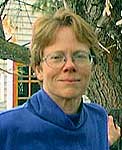Voices in Exile: Stories of Lesbian Mormons
A new documentary examines the lives of lesbian Mormons
Excerpted from The Light Horse: a websheet of politics and opinion
March 10, 2004
Filmmakers, like all storytellers, hope their craft will enlighten an audience. Stories and voices need to be heard, whether it’s to teach a moral, present an idea, embolden a cause, or to validate life’s struggles. Susan Randall, a documentary filmmaker, became fascinated with testimonials she was hearing from two friends. Both Mary and Brenda spoke of growing up Mormon in Idaho and coming to terms with their homosexuality. Captivated with the story they recounted, Randall knew she had a subject that needed not only exploration, but mostly a chance to be told.
Beginning with the first interview in November of 1999, Randall filmed lesbian Mormons willing to go on camera and speak of their experiences in the culture. Many women refused to be recorded, fearing loss of friends and family, as well as standing within the Church of Jesus Christ of Latter-day Saints (LDS) or Mormon Church. Whether filmed or not, the emerging stories focused on their pain and anguish as they dealt with perceived mutual exclusivity of being Mormon and lesbian. Randall received permission to work on the project for a few hours a week at BSU’s University Television Productions, where she works as Assistant Director.
The resulting 49 minute documentary will be shown next Tuesday, March 16th, in the BSU Student Union in conjunction with the school’s Women’s History Month celebration. Entitled Voices in Exile: Stories of Lesbian Mormons, the film begins at 6:30 p.m. in the Bishop Barnwell Room. The showing will mark only its second public viewing and will be followed by a panel discussion featuring current and former members of the LDS Church. The public is invited to the free event.
In producing Voices in Exile, Randall has filled a void in documenting the homosexual experience in Mormonism. While there are recent examples of scholarship concerning gay men in the Church, little documenting lesbians is available. That the film takes more of an oral history approach only ensures it greater accessibility. Randall states she made the film in hopes of promoting discussion, and specifically, to heal the pain surrounding the issue. The film was first shown at a Family Fellowship Forum in Salt Lake City last October, a support group of Mormon parents and friends of gay, lesbian, bisexual and transgender people. While she wonders if she is “preaching to the choir,” Randall envisions her work being seen by the broader LDS audience.
While the faithful and the Church itself will be uncomfortable with the documentary, Randall states that the film is not a slam against the Mormon faith. Indeed, parts of the stories told contain recollections of the good found within the religion; one interviewee even notes that it is a good way to raise children. A better critique of the film can be found in some of its production values. The voice-over during the Joseph Smith scene is particularly passionless. Also, the discussion of high schools and seminary incorrectly identifies a Pocatello secondary school as Centennial High – it’s actually Century High School. One of the quotes attributed to Hinckley is only cited as “Ensign;” interested parties will have to wait for the credits to get the full citation. And finally a stylistic point, as it may have reinforced the power of the stories and the courage of the women to note that the Mormon Church believes it is the only true church, thus having the power of God on earth. These are minor flaws to an otherwise very welcome film on a subject sorely in need of documenting. It will play a part in bringing about open dialogue, healing, and change.
For more information or to purchase a VHS copy of the film for $15, contact Susan Randall at 208-426-3468 or [email protected].
